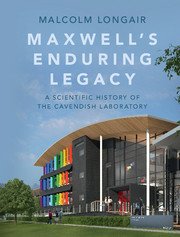Book contents
- Frontmatter
- Dedication
- Contents
- Preface
- Acknowledgements
- Part I To 1874
- Part II 1874 to 1879
- Part III 1879 to 1884
- Part IV 1884 to 1919
- 5 The challenges facing J.J. Thomson
- 6 The Thomson era, 1884–1900: the electron
- 7 The Thomson era, 1900–1919: atomic structure
- Part V 1919 to 1937
- Part VI 1938 to 1953
- Part VII 1953 to 1971
- Part VIII 1971 to 1982
- Part IX 1984 to 1995
- Part X 1995 to present
- Appendix The evolution of the New Museums site
- Notes
- References
- Author index
- Subject index
6 - The Thomson era, 1884–1900: the electron
from Part IV - 1884 to 1919
Published online by Cambridge University Press: 05 July 2016
- Frontmatter
- Dedication
- Contents
- Preface
- Acknowledgements
- Part I To 1874
- Part II 1874 to 1879
- Part III 1879 to 1884
- Part IV 1884 to 1919
- 5 The challenges facing J.J. Thomson
- 6 The Thomson era, 1884–1900: the electron
- 7 The Thomson era, 1900–1919: atomic structure
- Part V 1919 to 1937
- Part VI 1938 to 1953
- Part VII 1953 to 1971
- Part VIII 1971 to 1982
- Part IX 1984 to 1995
- Part X 1995 to present
- Appendix The evolution of the New Museums site
- Notes
- References
- Author index
- Subject index
Summary
Thomson's agenda
Prior to his appointment as Cavendish Professor, Thomson was uncertain about his ability to sustain a career in experimental physics and had the option of concentrating on theoretical studies. Once his appointment was announced, however, he put all his energies into fostering the experimental activities of all his colleagues in the Laboratory and developing his own experimental agenda through the appointment of an expert laboratory assistant, whose salary he paid from his own pocket. Ebeneezer Everett was appointed to this post in 1888 and was to remain until 1930 when he retired due to ill health. In his touching obituary of Everett, published in Nature in 1933, Thomson wrote:
Everett took a very active and important part in the researches carried on in the Laboratory, by students as well as by the professor. The great majority of these involved difficult glass blowing, which was nearly all done by Everett, as it was beyond the powers of most of the students. In addition to this, he made all the apparatus used in my experiments for the more than 40 years in which he acted as my assistant. I owe more than I can express to his skill and the zeal which he threw into his work. (Thomson, 1933)
For many reasons, 1895 was a turning point in the development of the Laboratory and so it is illuminating to list the titles of Thomson's papers up until that year (Table 6.1). It is apparent that his interests were wide-ranging, but increasingly there was a strong emphasis upon the conduction of electricity in gases, which dates back to his paper of 1883, the year before he was appointed to the Cavendish Chair. Before looking in more detail into these researches, let us review the role of analogy and model-building as tools for the understanding of physical phenomena.
Analogy andmodel-building
A distinctive feature of Maxwell's approach to the application of mathematics to natural philosophy was his ability to work by analogy. As early as 1856, when he was in his mid-20s, he described his approach in an essay entitled Analogies in Nature, written for the Apostles Club at Cambridge (Maxwell, 1856a). The essence of the technique can be caught in the following passage.
- Type
- Chapter
- Information
- Maxwell's Enduring LegacyA Scientific History of the Cavendish Laboratory, pp. 111 - 138Publisher: Cambridge University PressPrint publication year: 2016



